Geranium is a very beautiful and unpretentious flower that has always been popular. Even before the revolution, pots with geraniums could be seen on window sills in almost every peasant, bourgeois and aristocratic house. People have long known about the healing properties of plants. Geranium is used in medicine, and being taken to the garden in the summer, it relieves its green neighbors of aphids. In a word, geranium (pelargonium) is a good companion of people for many years. How to care for geraniums?
Material Content:
Geranium - cultivation features
Geranium can be safely recommended to beginner gardeners, it is a very simple flower to grow. Since the geranium fruits resemble a crane beak, the name of the flower translates as "crane".

Geranium takes root in each apartment, you only need to provide it with minimal comfort - sufficient, but not excessive watering, good lighting, air temperature above + 12 C. Since geranium came to us from southern countries, it does not tolerate frost, except for the garden variety, which Central Russia can even winter in the open ground.
In summer, geranium will be grateful to you if you take it out to the open air - to the balcony, or take it with you to the country. However, it is better to leave the plant in a pot, do not plant in the ground. It does not tolerate repeated transplantation and may die in the winter. In autumn, you will be surprised how magnificent and elegant the flower will become, what bright color its leaves will get.
Types and varieties of plants
Most often, flower lovers grow zonal pelargonium.This group, in turn, is divided into subgroups that differ in the shape of flowers, plant height, leaf color.

So, in the shape of a geranium flower there are:
- Non-double.
- Terry.
- Rosaceae.
- Stellate.
- Cactus-like.
- Tulip-shaped.
- Bird eggs.
- Speckled.
- Cloves.
- Phlox.
Based on the size, geraniums are isolated:
- standard - from 30 to 50 cm;
- dwarf - up to 25 cm;
- miniature - up to 15 cm.
Pelargonium leaves can be green or mottled when different shades are beautifully combined with each other - from bright green to rich purple.
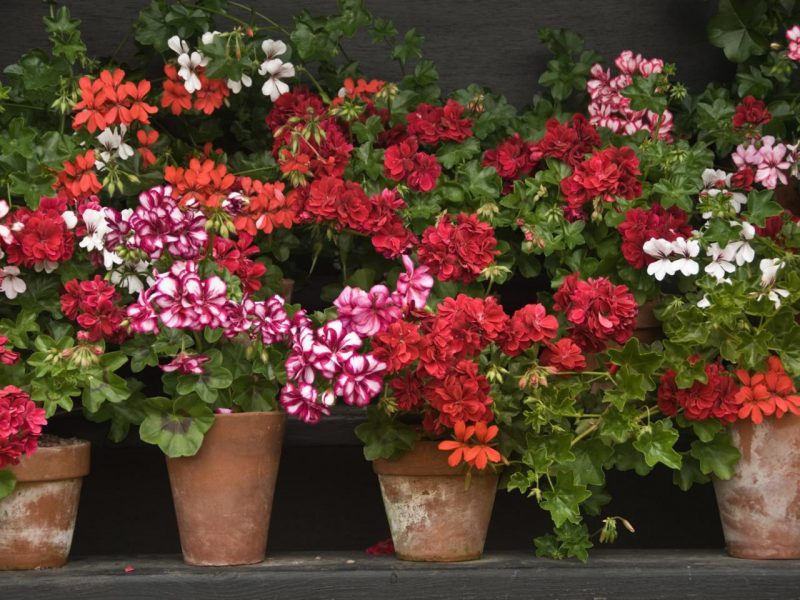
What other varieties of flower can be distinguished?
- Ampel geranium is intended for a cache-pot, as its branches hang down.
- Fragrant pelargonium is preferred by many flower lovers, since it has a distinctly expressed pleasant aroma. It can be different - for example, resembling the smell of roses or nutmeg.
- For royal geraniums, the feature is dark spots on flower petals.
- Angels are a type of pelargonium characterized by long flowering and delicate aroma.
- Garden geranium is intended for growing in flower beds, has a well-developed root system.
In addition, there are many hybrids that are popular with gardeners. In the end, every geranium lover collects a whole collection of different varieties on his windowsill.
How to care for geraniums at home for beginners
Although this is an undemanding plant, it will bloom profusely only with proper care. This is a sufficient amount of light, regular but moderate watering, acceptable temperature.
Soil requirements
Geranium does not show special requirements for soil. It’s easier to buy any ready-made primer for flowers from those sold in stores. Usually it contains peat, which is very good for geraniums.
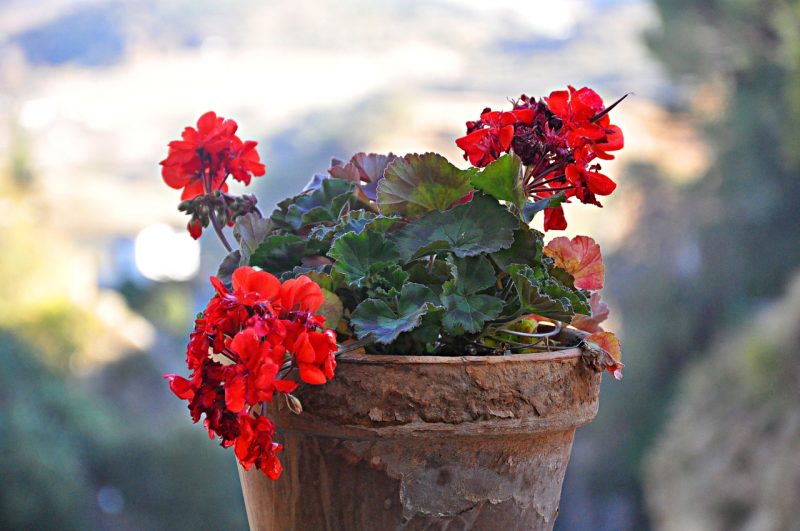
Even better, if there is an opportunity to add river sand and perlite to the soil.
If the soil mixture is prepared on its own, it is advisable to mix the turf soil, humus and sand in the following proportions 8: 2: 1.
Temperature, humidity, lighting
Pelargonium will grow normally and develop at ordinary room temperature. In winter, the thermometer in the room where the flower is located should not fall below + 12 C.
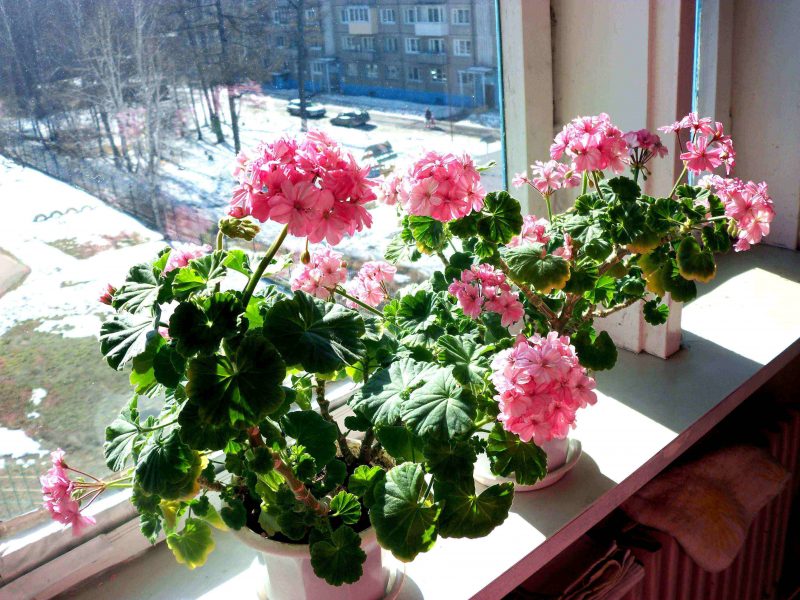
Caring for geraniums means providing adequate lighting. She loves the light. If you put the pot on the north window, the leaves will turn pale. But in the summer, on hot days, it’s better not to keep it in the bright sun so that the plant does not get burns, especially after watering
Pelargonium tolerates both dry and moist air, but does not like spraying. It is better in good weather to make it ventilate onto the balcony so that the plant "breathes".
Watering a plant
The frequency of watering depends on the time of year. In the warm period, indoor geranium is watered more often and more abundantly - this plant loves water very much. In winter, the frequency of watering is reduced - just “water” the flower once a week. But if the air in the rooms is overdried, and the soil in the flower pots dries quickly, you will have to water more often.
Fertilizer and fertilizer
Like other indoor plants, pelargonium requires complex fertilizers, which include nitrogen, phosphorus and potassium. Optimally, if they are included in the fertilizer in equal proportions.
The most convenient will be to purchase a mixture for flowering plants in the store, where the fertilizer additionally contains manganese, copper, iron.
Those who feed flowers on their own can add a drop of iodine to a liter of water. But in this case, pouring fertilizing should be careful, along the edges of the pot. Otherwise, iodine, especially in excessive concentration, can burn the roots.
In summer they feed 2 times a month, in spring and autumn - 1 time per month, in winter fertilizers can be omitted.
Top dressing should be done by removing the pot from a lighted window.Preliminary, the flower is well watered so that the mineral additives that make up the fertilizer do not damage the root system.
But geranium does not like manure and other organic fertilizers - it is better not to experiment with them.
Pruning and transplanting
Pelargonium refers to those plants that cease to bloom if transplanted into a too spacious pot. In this case, the root system begins to develop intensively, mastering the space, and the flowers do not bloom.
So geraniums are usually transplanted only in the following cases:
- If the root system has grown too much, it is already visible above the ground.
- If the plant becomes sick, for example, it begins to rot from excessive watering.
A new pot is chosen so that the roots completely fit into it.
It is better to transplant a plant in early spring. In advance, you should stock up on drainage and suitable soil - purchased or prepared independently.
Geraniums are carefully removed from the pot, trying not to damage the roots, and watered abundantly in a new place.
In autumn, it should be cut, removing shoots coming from the axils of the leaves. On the stem should be no more than 7 leaves.
Care for geraniums in the fall, preparation for winter.
In September, pelargoniums, if they spent the summer outdoors, are brought into the house. You need to water the flowers less often, and the amount of fertilizer decreases.
When the plant adapts to new conditions, cut off excess shoots. Royal geraniums are pruned a little later, in late autumn. This is best done in late October or November.
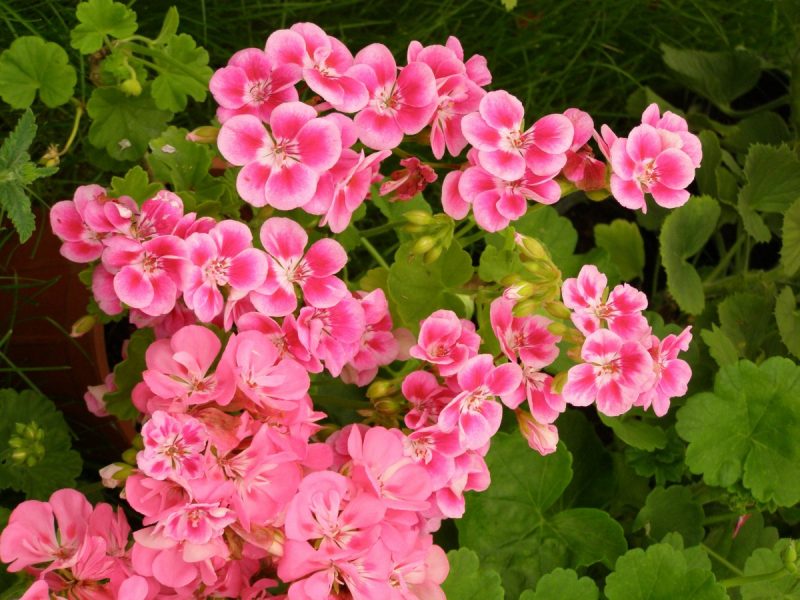
For the purpose of prevention, flowers are treated with Fundazol. They carefully examine whether any pests were brought along with geraniums from the garden.
The best option would be to put geraniums for the winter on an insulated balcony, where the temperature does not drop below + 15. But you can leave it in the room, placing the flower closer to the glass (but not in the draft).
For miniature and variegated geraniums, it is desirable to provide additional lighting in winter with fluorescent lamps. Watering during the cold season should be moderate, but regular.
Plant propagation
Geranium can be propagated by both cuttings and seeds.
To obtain cuttings, tops with 3-4 leaves are cut, and placed in a container with water. When the roots appear - cuttings are planted in pots with earth. You can cover them with glass jars for several days.
Geraniums propagated by cuttings in the spring.
To propagate new varieties, seeds are sown in late February or early March using loose, nutrient-rich soil.
If the earth is taken from its site, it must first be poured with a solution of potassium permanganate for disinfection.
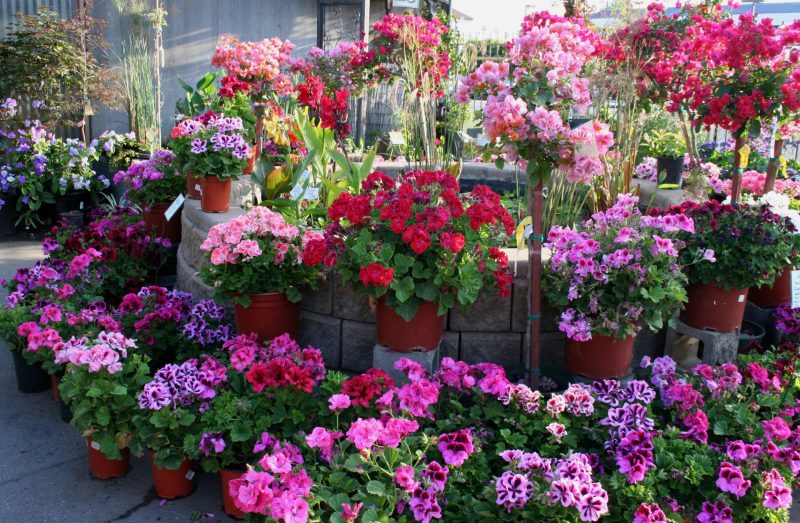
Seeds germinate better if you cover the box with film. Small plants will need additional lighting, fluorescent lamps can be used. After about 2 months, they are seated in separate pots.
Pest and Disease Control
Geranium is a healthy plant, and yet it happens that the flower is sometimes affected by pests or various ailments.
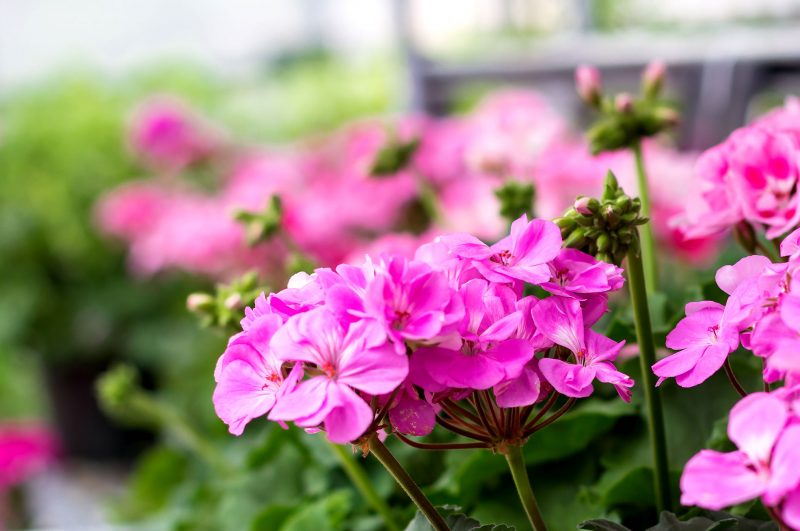
The most common diseases are:
- Gray rot on the leaves. Sick leaves are carefully removed, and the bush is sprayed with antifungal drugs.
- Root rot - occurs with frequent watering. It is advisable to transplant a flower by cutting off rotten roots.
- Whitefly It is possible to suspect the appearance of a pest if the leaves of a geranium suddenly begin to turn yellow. A drug like Actellic will be required. Perhaps processing will have to be done several times.
- Powdery Mildew The leaves acquire a characteristic appearance, covered with a whitish coating. This is a fungal disease, and it is necessary to treat using Topsin-M or Topaz preparations.
- Aphid. Tiny creatures can be seen on the undersides of leaves. Many drugs are sold in stores that help get rid of pests.
- Rust is a fungal disease, it is characterized by the appearance of rusty spots on the leaves.For treatment, fungicides are used.
In addition, geraniums can hurt and stop blooming if the conditions of detention are violated. For example, there is not enough light or the soil is too wet.
In general, subject to simple rules, a flowering bush will become the main decoration of your window.












